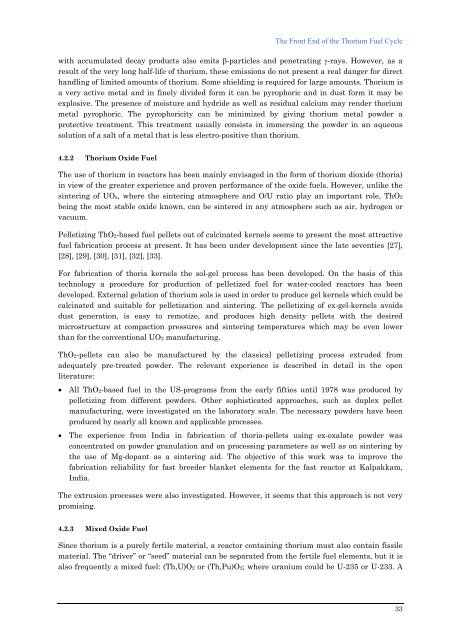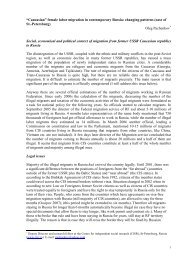THORIUM AS AN ENERGY SOURCE - Opportunities for Norway ...
THORIUM AS AN ENERGY SOURCE - Opportunities for Norway ...
THORIUM AS AN ENERGY SOURCE - Opportunities for Norway ...
Create successful ePaper yourself
Turn your PDF publications into a flip-book with our unique Google optimized e-Paper software.
The Front End of the Thorium Fuel Cycle<br />
with accumulated decay products also emits β-particles and penetrating γ-rays. However, as a<br />
result of the very long half-life of thorium, these emissions do not present a real danger <strong>for</strong> direct<br />
handling of limited amounts of thorium. Some shielding is required <strong>for</strong> large amounts. Thorium is<br />
a very active metal and in finely divided <strong>for</strong>m it can be pyrophoric and in dust <strong>for</strong>m it may be<br />
explosive. The presence of moisture and hydride as well as residual calcium may render thorium<br />
metal pyrophoric. The pyrophoricity can be minimized by giving thorium metal powder a<br />
protective treatment. This treatment usually consists in immersing the powder in an aqueous<br />
solution of a salt of a metal that is less electro-positive than thorium.<br />
4.2.2 Thorium Oxide Fuel<br />
The use of thorium in reactors has been mainly envisaged in the <strong>for</strong>m of thorium dioxide (thoria)<br />
in view of the greater experience and proven per<strong>for</strong>mance of the oxide fuels. However, unlike the<br />
sintering of UOx, where the sintering atmosphere and O/U ratio play an important role, ThO2<br />
being the most stable oxide known, can be sintered in any atmosphere such as air, hydrogen or<br />
vacuum.<br />
Pelletizing ThO2-based fuel pellets out of calcinated kernels seems to present the most attractive<br />
fuel fabrication process at present. It has been under development since the late seventies [27],<br />
[28], [29], [30], [31], [32], [33].<br />
For fabrication of thoria kernels the sol-gel process has been developed. On the basis of this<br />
technology a procedure <strong>for</strong> production of pelletized fuel <strong>for</strong> water-cooled reactors has been<br />
developed. External gelation of thorium sols is used in order to produce gel kernels which could be<br />
calcinated and suitable <strong>for</strong> pelletization and sintering. The pelletizing of ex-gel-kernels avoids<br />
dust generation, is easy to remotize, and produces high density pellets with the desired<br />
microstructure at compaction pressures and sintering temperatures which may be even lower<br />
than <strong>for</strong> the conventional UO2 manufacturing.<br />
ThO2-pellets can also be manufactured by the classical pelletizing process extruded from<br />
adequately pre-treated powder. The relevant experience is described in detail in the open<br />
literature:<br />
• All ThO2-based fuel in the US-programs from the early fifties until 1978 was produced by<br />
pelletizing from different powders. Other sophisticated approaches, such as duplex pellet<br />
manufacturing, were investigated on the laboratory scale. The necessary powders have been<br />
produced by nearly all known and applicable processes.<br />
• The experience from India in fabrication of thoria-pellets using ex-oxalate powder was<br />
concentrated on powder granulation and on processing parameters as well as on sintering by<br />
the use of Mg-dopant as a sintering aid. The objective of this work was to improve the<br />
fabrication reliability <strong>for</strong> fast breeder blanket elements <strong>for</strong> the fast reactor at Kalpakkam,<br />
India.<br />
The extrusion processes were also investigated. However, it seems that this approach is not very<br />
promising.<br />
4.2.3 Mixed Oxide Fuel<br />
Since thorium is a purely fertile material, a reactor containing thorium must also contain fissile<br />
material. The “driver” or “seed” material can be separated from the fertile fuel elements, but it is<br />
also frequently a mixed fuel: (Th,U)O2 or (Th,Pu)O2; where uranium could be U-235 or U-233. A<br />
33

















